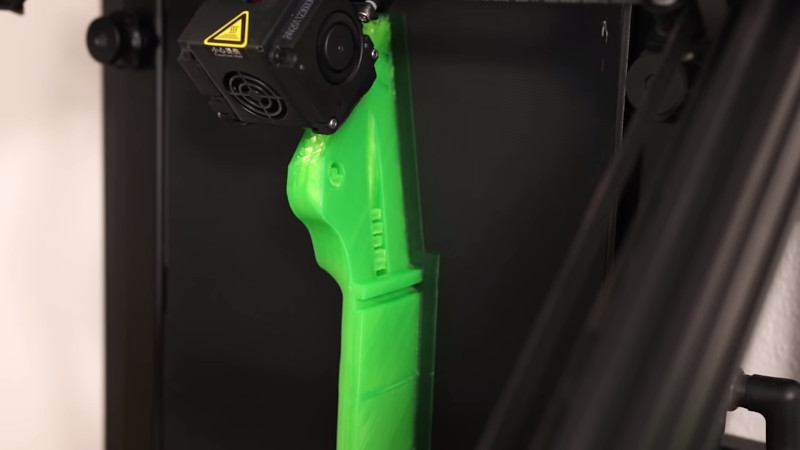A lot of first-time guitar builders focus on making the body and skip the neck, which has lots of tricky dimensions to get right to if you want a nicely playable instrument. However, [Jón Schone] of Proper Printing wanted to start with the hard part on his guitar building journey, and set about 3D printing a guitar neck in one piece.
Designing a neck might sound difficult on the surface of it, but the Marz Guitar Designer plugin for FreeCAD helps make whipping one up a cinch. Once imported into Fusion 360, the geometry is tweaked for 3D printing, particularly to fit the truss rod inside. Printed on a Creality CF30 belt printer (which interestingly enough, has been mounted to the wall) in green PLA, the resulting neck can be spotted as a non-traditional design from a mile away. With a truss rod hammered in, frets installed, and hardware attached, it’s mounted up to a cheap kit guitar for testing.
The printed neck works, and it’s given a proper shakedown with some appropriate riffs to put it through its paces. It’s reportedly a bit on the flexible side, but remains playable and is surprisingly normal in its performance. [Jón] now plans to continue the project by 3D printing the rest of the guitar.
Meanwhile, if you’re sick of tuning your own guitar, consider building a robot tuner to help out. Video after the break.
[Thanks to Zane Atkins for the tip!]
















He probably should have used more infill to make it stiffer. Otherwise go all-in an try to print a neck-through-body guitar!
That isnt going to work with thirteens and the hands that use them,bleck,ooobleck.
On the other hand plastic horns,trombones,trumpets,etc are
much less expensive than brass and sound fine,at least with
the plastic bieng used,and no one has to hand $3000 of
brass to a clumsy kid.splatflataphone.
at first i couldn’t believe it, how could it be strong enough for the sustained tension? then i saw it has a truss rod so it will be mostly compressive forces, so ok??? but then i see, the headstock (where the tuning machines are mounted) is beyond that….the force on that must be enormous by the standards of PLA. if you left it strung up overnight would it fail on the first night or maybe it’ll last a week??
Even if it doesn’t bend outright, it will never hold a tune. Watching the vid, it was printed bent (not intentionally) and straightened by banging a steel rod down the hole (insert mom joke here).
Aluminum necked guitars are notorious for needing constant tuning, because thermal expansion when played by warm blooded creature. PLA is worse.
Yeah this will never work without some reinforcement in the headstock. Maybe if the tuners were mounted on an extension of the truss rod or something? Or I wonder if a headless neck (think like a Steinberger) would be doable…
I’d be interested in the tuning stability of that neck during any temperature changes.
On the plus side, you would never have to worry about anything humidity related like fret sprout.
Fun project. Obviously it could be better, but + points for first go and enthusiasm.
Rather gone the other way from 3D printed parts for guitars. Made a bridge out of tungsten to increase sustain. 3 hours with an angle grinder to carve it. Tungsten is hard!
Please read MSDS on Tungsten carbide before you grind on it anymore.
Seriously, unless you already did and protected your lungs. Then ignore this post.
Cleanup the dust ASAP. Again, unless you already did.
It’s very bad for everybody, but there a are about 2% of the population that just dies in agony if they get a _little_ Cobalt in there lungs. (Cobalt is usually the metal that binds together carbide grains, because it wets it, surface tension. See also p-chem.)
Short version: It’s like black lung disease, but doesn’t take 20 years.
He might have better results if he’d printed a mold to forge a carbon fiber neck in.
Yeah I love his videos, especially the printing a wheel for a car series. Dude is a maniacal genius.
I have two Emerald guitars and a Rainsong 12 string all moulded in one piece from carbon fibre. No tuning problems, no heat/cold issues and excellent playability and resonance. I also have a Canadian Riversong wooden guitar with a detachable neck. No complaints with it at all but it’s a standard 25.5″ scale and I’m considering getting a 24.5″ made to replace it. Would this be possible via a 3d printer?